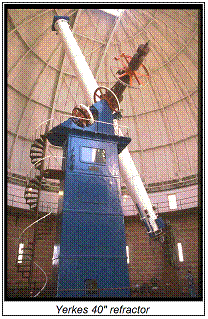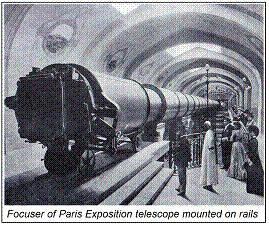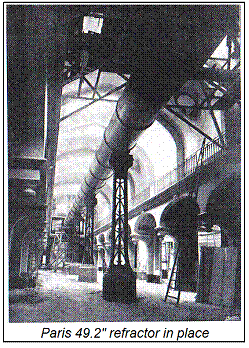Early History of the Telescope
Jack Kramer
Part III: Refractor vs Reflector While refractors remained smaller than reflectors, the quality of their images made them the choice for major observatories. In the late 1700's, a major improvement occurred as a result of John Dollond's development of an achromatic ("non-chromatic") objective lens system for refracting telescopes. Typically, two separate lenses are used for the objective, one of crown glass and the other of flint. Flint glass is softer, so it was generally the element that faced the inside of the telescope. Chromatic aberration in refractors was now greatly diminished.
Charles Messier provides a good example of the situation at this time. During the period from 1765 to 1807, he used both refractors and reflectors. For awhile, his favorite was a 71/2-inch Gregorian reflector with a focal length of 32-feet, giving a magnification of 104x. Because of the speculum metal mirror, however, this provided light gathering equivalent to only about a 31/2-inch refractor. Messier later did adopt a 31/2-inch achromatic refractor giving 120x. Though his records list many telescopes, seldom is the aperture shown, only the focal length and magnification. Apparently, the interchangeable eyepiece was not common at this time. Surely, astronomers must have been aware of the connection between aperture and light-gathering. The fact that Messier seldom mentions aperture might be due to the fact that the technology wasn't able to produce consistently good large optics; therefore, aperture was of secondary importance. The size of Messier's telescopes should give some encouragement to those who set out to find all the Messier objects using modest instruments.
Despite advances in reflector optics, astronomers up to the late 19th century still preferred refracting telescopes because of their image quality. Another major concern was that the configuration of the large reflectors and the manufacturing capability of the time created some unwieldy mechanical and observer-access problems.
 By the late 1800's, optical glass for large refractor lenses had improved markedly. Several telescope makers had achieved renown for the quality of their instruments - they included the famous names of Clark, Brashear, and Mogey. Most major discoveries before the 20th century were made using refractors. For example, it was with the Lick 36" refractor that E. E. Barnard discovered the fifth moon of Jupiter in 1892, at last expanding beyond the four originally found by Galileo. As late as 1930, Pluto was discovered with the Lowell Observatory 13-inch refractor.
By the late 1800's, optical glass for large refractor lenses had improved markedly. Several telescope makers had achieved renown for the quality of their instruments - they included the famous names of Clark, Brashear, and Mogey. Most major discoveries before the 20th century were made using refractors. For example, it was with the Lick 36" refractor that E. E. Barnard discovered the fifth moon of Jupiter in 1892, at last expanding beyond the four originally found by Galileo. As late as 1930, Pluto was discovered with the Lowell Observatory 13-inch refractor.
The epitome was reached with the 40-inch at Yerkes Observatory, which was completed in 1897 and housed in a dome 90 feet in diameter. Alvan Clark, who made the 40-inch lens, felt that a still larger refractor would be impossible because the weight of the glass would cause the lenses to sag and lose their figure. Unlike a mirror, a lens can only be supported around its circumference.
But the Yerkes telescope was not the largest refractor ever built. The largest was constructed for the Paris Exposition of 1900. It had a 49.2-inch objective with a focal length of 187-feet. With this focal ratio (f/45.6), the lowest magnification was 500x! Even its mounting was unconventional. It was mounted horizontally using a siderostat mirror of 79-inches to feed the object to the primary lens. Focusing was done by means of a carriage on rails, with a focus travel of 5 feet. But the results were poor, owing to a bad location and a steel tube with no ventilation. The telescope would not fit under a conventional observatory dome and after the year-long exposition was over, its builders were unable to sell it to any institution. The telescope was ultimately scrapped.
 The later history of the telescope certainly belongs to the reflector. Leon Foucault in 1859 announced his development of silvered glass parabolic mirrors, so speculum metal mirrors were quickly abandoned in favor of glass. By 1900, most astronomers had switched their preference to reflectors for their ability to be made quite large, thus providing much more light gathering. As they probed the edge of the universe, it became clear that the future of astronomy would be tied to the reflector.
The later history of the telescope certainly belongs to the reflector. Leon Foucault in 1859 announced his development of silvered glass parabolic mirrors, so speculum metal mirrors were quickly abandoned in favor of glass. By 1900, most astronomers had switched their preference to reflectors for their ability to be made quite large, thus providing much more light gathering. As they probed the edge of the universe, it became clear that the future of astronomy would be tied to the reflector.
 The Hooker 100-inch reflector at Mount Wilson is an example of a new generation of instruments in the twentieth century. It was completed in 1917, but its primary mirror maintains a tie with the past. The mirror blank was cast by the St. Gobain Glass Works in France. Throughout its history, this firm had derived much of its revenue from the production of the green-colored bottles used to protect vintage French wines. Not wanting to depart from tradition, the mirror for the 100-inch was cast out of green glass!
The Hooker 100-inch reflector at Mount Wilson is an example of a new generation of instruments in the twentieth century. It was completed in 1917, but its primary mirror maintains a tie with the past. The mirror blank was cast by the St. Gobain Glass Works in France. Throughout its history, this firm had derived much of its revenue from the production of the green-colored bottles used to protect vintage French wines. Not wanting to depart from tradition, the mirror for the 100-inch was cast out of green glass!
 Among its accomplishments, in 1920 the 100-inch was used to pioneer the technique of stellar interferometry using coordinated observations from widely separated telescopes to examine the features of stars to unprecedented levels of detail.
Among its accomplishments, in 1920 the 100-inch was used to pioneer the technique of stellar interferometry using coordinated observations from widely separated telescopes to examine the features of stars to unprecedented levels of detail.
However, plate glass was unstable, and as such, it was difficult to figure. Then once the mirror was installed in a telescope, the figure again changed with changes in temperature. These problems were largely solved when in 1915 Corning Glass introduced Pyrex, a shock-resistant borosilicate glass. But there was still the difficulty of casting very large mirror blanks, as exemplified in the story of the 200-inch Hale telescope.
An important part of the history of the telescope involves the sites where they were built. Especially with the coming of large reflectors, it was realized that the location of the telescope plays a critical role in the performance of the instrument. Yerkes was the last major observatory to be constructed near sea level. The Lick Observatory 36" refractor had been installed on Mount Hamilton in California, and this signaled the migration to mountaintops that was to come. Mount Wilson now suffers from the light pollution of Los Angeles, but the quality of the seeing there is still regarded among the best at any of the observatory sites.
The development of large refractors came to an abrupt end with Yerkes. But not all telescopes of the past have been relegated to serving as museum pieces. Some are still used for important research work where image quality is especially important. In studies of the cosmic distance scale, traditional measurements of the distances to stars are unreliable beyond 100 light years. Trigonometric parallax is the most precise method of measurement, and the rest of the distance scale is built off it. At this scale, angles are very difficult to measure, so the Allegheny Observatory 30-inch Thaw refractor has been fitted with equipment for multichannel astrometric photometry in order to measure parallax to an unprecedented accuracy of 1 milliarcsecond.
The Yerkes 40-inch has done spectroscopic work and photometry, which is the direct measurement of photons to create intensity traces that are used to measure star magnitudes precisely to 0.01 magnitude. The 40-inch was used to re-photograph stars that it originally photographed around 1910 to see how much they have moved in the intervening years. By using the same telescope over a long span of years, the image scale remains the same so that the positions of stars can be measured with significantly higher precision.
At Mount Wilson, the Hooker 100-inch reflector has been pulled out of mothballs to be used for remote imaging and binary star speckle interferometry, a cutting-edge way to measure the magnitudes and colors of individual binary stars. It's finding renewed usefulness in the study of point sources such as individual stars and clusters, and in solar system work where objects are not as severely affected by light pollution.
Over the past 400 years there have been a number of design variations in the refractor and reflector. The important point is that telescopes are a technology with great longevity. Many of the old telescopes that survive can still be useful instruments. Galileo may have started it all, but many others played important roles.
Published in the December 2008 issue of the NightTimes




